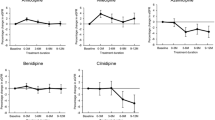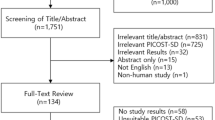Abstract
Background
Early trials of dihydropyridine calcium channel blockers (DCCBs) suggest a detrimental effect on intraglomerular pressure and an association with albuminuria.
Objective
We sought to evaluate the associations of DCCB initiation with albuminuria and kidney failure with replacement therapy (KFRT) and to determine whether renin-angiotensin system (RAS) blockade modified these associations.
Design
We conducted a target trial emulation study using a new user, active comparator design and electronic health record data from Geisinger Health.
Participants
We included patients without severe albuminuria or KFRT who were initiated on a DCCB or thiazide (active comparator) between January 1, 2004, and December 31, 2019.
Main Measures
Using inverse probability of treatment weighting, we performed doubly robust Cox proportional hazards regression to estimate the association of DCCB initiation with incident severe albuminuria (urine albumin to creatinine ratio > 300 mg/g) and KFRT, overall and stratified by RAS blocker use.
Key Results
There were 11,747 and 26,758 eligible patients initiating a DCCB and thiazide, respectively, with a weighted baseline mean age of 60 years, systolic blood pressure of 143 mm Hg, and eGFR of 86 mL/min/1.73 m2, and with a mean follow-up of 8 years. Compared with thiazides, DCCBs were significantly associated with the development of severe albuminuria (hazard ratio [HR], 1.29; 95% confidence interval [CI], 1.16–1.43), with attenuation of risk in the presence of RAS blockade (P for interaction < 0.001). The risk of KFRT was increased among patients without RAS blockade (HR, 1.66; 95% CI, 1.19–2.31), but not with RAS blockade (P for interaction = 0.005).
Conclusions
DCCBs were associated with increased risk of albuminuria and, in the absence of RAS blockade, KFRT. These findings suggest coupling DCCB therapy with RAS blockade may mitigate adverse kidney outcomes.

Similar content being viewed by others
Data Availability:
The datasets analyzed during the current study are not publicly available because they contain protected health information.
References
Casey DE, Karen Collins Faha J, Cheryl Dennison Himmelfarb Mba, et al. 2017 ACC/AHA/AAPA/ABC/ACPM/AGS/APhA/ASH/ASPC/NMA/PCNA Guideline for the Prevention, Detection, Evaluation, and Management of High Blood Pressure in Adults: a Report of the American College of Cardiology/American Heart Association Task Force on Clinical Practice Guidelines. J Am Coll Cardiol. 2018;71(19):e127-e248. https://doi.org/10.1016/J.JACC.2017.11.006
Guideline for the Pharmacological Treatment of Hypertension in Adults. World Health Organization; 2021. Accessed January 6, 2023. http://www.ncbi.nlm.nih.gov/books/NBK573631/
Jaffe MG, Frieden TR, Campbell NRC, et al. Recommended Treatment Protocols to Improve Management of Hypertension Globally: a Statement by Resolve to Save Lives and the World Hypertension League (WHL). J Clin Hypertens Greenwich Conn. 2018;20(5):829-836. https://doi.org/10.1111/jch.13280
Shah SJ, Stafford RS. Current Trends of Hypertension Treatment in the United States. Am J Hypertens. 2017;30(10):1008-1014. https://doi.org/10.1093/ajh/hpx085
An J, Luong T, Qian L, et al. Treatment Patterns and Blood Pressure Control With Initiation of Combination Versus Monotherapy Antihypertensive Regimens. Hypertension. 2021;77(1):103-113. https://doi.org/10.1161/HYPERTENSIONAHA.120.15462
Derington CG, King JB, Herrick JS, et al. Trends in Antihypertensive Medication Monotherapy and Combination Use Among US Adults, National Health and Nutrition Examination Survey 2005–2016. Hypertension. Published online 2020:973-981. https://doi.org/10.1161/HYPERTENSIONAHA.119.14360
Wang JG, Kario K, Lau T, et al. Use of Dihydropyridine Calcium Channel Blockers in the Management of Hypertension in Eastern Asians: a Scientific Statement from the Asian Pacific Heart Association. Hypertens Res. 2011;34(4):423-430. https://doi.org/10.1038/hr.2010.259
Blood Pressure Lowering Treatment Trialists’ Collaboration. Pharmacological Blood Pressure Lowering for Primary and Secondary Prevention of Cardiovascular Disease Across Different Levels of Blood Pressure: an Individual Participant-Level Data Meta-Analysis. Lancet. 2021;397(10285):1625-1636. https://doi.org/10.1016/S0140-6736(21)00590-0
Hayashi K, Wakino S, Sugano N, Ozawa Y, Homma K, Saruta T. Ca2+ Channel Subtypes and Pharmacology in the Kidney. Circ Res. 2007;100(3):342-353. https://doi.org/10.1161/01.RES.0000256155.31133.49
Matsushita K, van der Velde M, Astor BC, et al. Association of Estimated Glomerular Filtration Rate and Albuminuria with All-Cause and Cardiovascular Mortality in General Population Cohorts: a Collaborative Meta-Analysis. Lancet. 2010;375(9731):2073-2081. https://doi.org/10.1016/S0140-6736(10)60674-5
Gansevoort RT, Matsushita K, Van Der Velde M, et al. Lower Estimated GFR and Higher Albuminuria Are Associated with Adverse Kidney Outcomes. A Collaborative Meta-Analysis of General and High-Risk Population Cohorts. Kidney Int. 2011;80(1):93-104. https://doi.org/10.1038/KI.2010.531
Van Velde MD, Halbesma N, De Charro FT, et al. Screening for Albuminuria Identifies Individuals at Increased Renal Risk. J Am Soc Nephrol. 2009;20(4):852-862. https://doi.org/10.1681/ASN.2008060655
Ishani A, Grandits GA, Grimm RH, et al. Association of Single Measurements of Dipstick Proteinuria, Estimated Glomerular Filtration Rate, and Hematocrit with 25-Year Incidence of End-Stage Renal Disease in the Multiple Risk Factor Intervention Trial. J Am Soc Nephrol. 2006;17(5):1444-1452. https://doi.org/10.1681/ASN.2005091012
Griffin KA, Picken MM, Bidani AK. Deleterious Effects of Calcium Channel Blockade on Pressure Transmission and Glomerular Injury in Rat Remnant Kidneys. J Clin Invest. 1995;96(2):793-800. https://doi.org/10.1172/JCI118125
Griffin KA, Bidani AK. Progression of Renal Disease: Renoprotective Specificity of Renin-Angiotensin System Blockade. Clin J Am Soc Nephrol. 2006;1(5):1054-1065. https://doi.org/10.2215/CJN.02231205
Bakris GL, Weir MR, Secic M, Campbell B, Weis-McNulty A. Differential Effects of Calcium Antagonist Subclasses on Markers of nephropathy Progression. Kidney Int. 2004;65(6):1991-2002. https://doi.org/10.1111/J.1523-1755.2004.00620.X
Wright JT, Bakris G, Greene T, et al. Effect of Blood Pressure Lowering and Antihypertensive Drug Class on Progression of Hypertensive Kidney Disease: Results From the AASK Trial. JAMA. 2002;288(19):2421-2431. https://doi.org/10.1001/JAMA.288.19.2421
Rahman M, Ford CE, Cutler JA, et al. Long-Term Renal and Cardiovascular Outcomes in Antihypertensive and Lipid-Lowering Treatment to Prevent Heart Attack Trial (ALLHAT) Participants by Baseline Estimated GFR. Clin J Am Soc Nephrol. 2012;7(6):989-1002. https://doi.org/10.2215/CJN.07800811
Rahman M, Pressel S, Davis BR, et al. Renal Outcomes in High-Risk Hypertensive Patients Treated with an Angiotensin-Converting Enzyme Inhibitor or a Calcium Channel Blocker vs a Diuretic: a Report from the Antihypertensive and Lipid-Lowering Treatment to Prevent Heart Attack Trial (ALLHAT). Arch Intern Med. 2005;165(8):936-946. https://doi.org/10.1001/ARCHINTE.165.8.936
Furberg CD, Wright JT, Davis BR, et al. Major Outcomes in High-Risk Hypertensive Patients Randomized to Angiotensin-Converting Enzyme Inhibitor or Calcium Channel Blocker vs Diuretic: the Antihypertensive and Lipid-Lowering Treatment to Prevent Heart Attack Trial (ALLHAT). JAMA. 2002;288(23):2981-2997. https://doi.org/10.1001/JAMA.288.23.2981
Sumida K, Nadkarni GN, Grams ME, et al. Conversion of Urine Protein–Creatinine Ratio or Urine Dipstick Protein to Urine Albumin–Creatinine Ratio for Use in Chronic Kidney Disease Screening and Prognosis: an Individual Participant–Based Meta-Analysis. Ann Intern Med. 2020;173(6):426-435. https://doi.org/10.7326/M20-0529/SUPPL_FILE/M20-0529_SUPPLEMENT.PDF
Inker LA, Eneanya ND, Coresh J, et al. New Creatinine- and Cystatin C-Based Equations to Estimate GFR Without Race. N Engl J Med. 2021;385(19):1737-1749. https://doi.org/10.1056/NEJMOA2102953
Qiao Y, Shin JI, Chen TK, et al. Association Between Renin-Angiotensin System Blockade Discontinuation and All-Cause Mortality Among Persons With Low Estimated Glomerular Filtration Rate. JAMA Intern Med. 2020;180(5):718-726. https://doi.org/10.1001/jamainternmed.2020.0193
Rubin D. Multiple Imputation for Nonresponse in Surveys. (John Wiley & Sons, ed.).; 2004. https://books.google.com/books?hl=en&lr=&id=bQBtw6rx_mUC&oi=fnd&pg=PR24&ots=8PuF5L6ZhQ&sig=BUDoFYT3Bq6ietIx4aV6xUyOVHI
Jafar TH, Stark PC, Schmid CH, et al. Progression of Chronic Kidney Disease: the Role of Blood Pressure Control, Proteinuria, and Angiotensin-Converting Enzyme Inhibition: a Patient-Level Meta-Analysis. Ann Intern Med. 2003;139(4). https://doi.org/10.7326/0003-4819-139-4-200308190-00006
Jafar TH, Schmid CH, Landa M, et al. Angiotensin-Converting Enzyme Inhibitors and Progression of Nondiabetic Renal Disease. A Meta-Analysis of Patient-Level Data. Ann Intern Med. 2001;135(2):73-87. https://doi.org/10.7326/0003-4819-135-2-200107170-00007
Hart P, Bakris GL. Calcium Antagonists: Do They Equally Protect Against Kidney Injury? Kidney Int. 2008;73(7):795-796. https://doi.org/10.1038/SJ.KI.5002773
Chagnac A, Zingerman B, Rozen-Zvi B, Herman-Edelstein M. Consequences of Glomerular Hyperfiltration: the Role of Physical Forces in the Pathogenesis of Chronic Kidney Disease in Diabetes and Obesity. Nephron. 2019;143(1):38-42. https://doi.org/10.1159/000499486
Griffin KA, Picken MM, Bakris GL, Bidani AK. Class Differences in the Effects of Calcium Channel Blockers in the Rat Remnant Kidney Model. Kidney Int. 1999;55(5):1849-1860. https://doi.org/10.1046/J.1523-1755.1999.00434.X
Moes AD, Hesselink DA, van den Meiracker AH, Zietse R, Hoorn EJ. Chlorthalidone Versus Amlodipine for Hypertension in Kidney Transplant Recipients Treated With Tacrolimus: a Randomized Crossover Trial. Am J Kidney Dis. 2017;69(6):796-804. https://doi.org/10.1053/J.AJKD.2016.12.017
Taal MW, Brenner BM. Renoprotective Benefits of RAS Inhibition: from ACEI to Angiotensin II Antagonists. Kidney Int. 2000;57(5):1803-1817. https://doi.org/10.1046/J.1523-1755.2000.00031.X
Fogari R, Preti P, Zoppi A, et al. Effects of Amlodipine Fosinopril Combination on Microalbuminuria in Hypertensive Type 2 Diabetic Patients. Am J Hypertens. 2002;15(12):1042-1049. https://doi.org/10.1016/S0895-7061(02)03017-0
Bakris GL, Sarafidis PA, Weir MR, et al. Renal Outcomes with Different Fixed-Dose Combination Therapies in Patients with Hypertension at High Risk for Cardiovascular Events (ACCOMPLISH): a Prespecified Secondary Analysis of a Randomised Controlled Trial. Lancet. 2010;375(9721):1173-1181. https://doi.org/10.1016/S0140-6736(09)62100-0
Acknowledgements:
Dr. Blum was supported by NHLBI T32HL139426. Dr. Shin was supported by NIDDK K01DK121825. Dr. Grams was supported by NHLBI K24HL155861 and NIDDK R01DK115534.
Author information
Authors and Affiliations
Corresponding author
Ethics declarations
Conflict of Interest:
Dr. Blum reports grants or contracts: National Kidney Foundation and Johns Hopkins University; meeting or travel support: American Society of Nephrology. Dr. Chang reports grants or contracts: Bayer, Novartis, Novo Nordisk; consulting fees: Novartis, Reata, Amgen; data safety monitoring board or advisory board: Occurrence of Dyskalemia with Treatment for Hypertension Study. Dr. Inker reports grants or contracts: National Kidney Foundation, National Institutes of Health, Omeros, Dialysis Clinics Inc., Reata; consulting fees: Tufts Medical Center; data safety monitoring board or advisor board: Dimerix, TMC, Tricida, Healthlogistics. Dr. Chen reports grants or contracts: National Institutes of Health, Yale University; payment or honoraria: American Society of Nephrology; meeting or travel support: CKD Biomarkers Consortium Meeting. Dr. Grams reports grants or contracts: National Institutes of Health and National Kidney Foundation; payment or honoraria: University of Pennsylvania, Columbia University Medical Center, American Society of Nephrology; meeting/travel support: Kidney Disease Improving Global Outcomes, European Renal Association, University of Pennsylvania, and Korean Society of Nephrology; leadership or fiduciary role: American Society of Nephrology, Kidney Disease: Improving Global Outcomes, National Kidney Foundation, United States Renal Data System, American Society of Clinical Investigation, Clinical Journal of American Society of Nephrology, American Journal of Kidney Diseases, and Journal of American Society of Nephrology. The remaining authors declare that they have no relevant financial interests.
Additional information
Publisher's Note
Springer Nature remains neutral with regard to jurisdictional claims in published maps and institutional affiliations.
This study was presented as an abstract at the American Society of Nephrology Kidney Week, Orlando, Florida, November 4, 2022.
Supplementary Information
Below is the link to the electronic supplementary material.
Rights and permissions
Springer Nature or its licensor (e.g. a society or other partner) holds exclusive rights to this article under a publishing agreement with the author(s) or other rightsholder(s); author self-archiving of the accepted manuscript version of this article is solely governed by the terms of such publishing agreement and applicable law.
About this article
Cite this article
Blum, M.F., Surapaneni, A., Chang, A. et al. Dihydropyridine Calcium Channel Blockers and Kidney Outcomes. J GEN INTERN MED (2024). https://doi.org/10.1007/s11606-024-08762-2
Received:
Accepted:
Published:
DOI: https://doi.org/10.1007/s11606-024-08762-2




